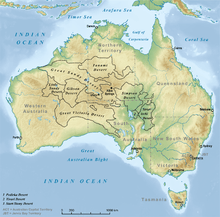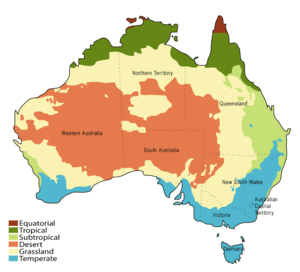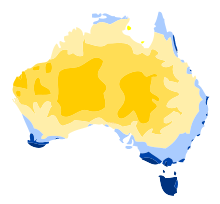Deserts of Australia




Named deserts of Australia cover 1,371,000 square kilometres (529,000 sq mi), or 18% of the Australian mainland. However, approximately 35% of the Australian continent receives so little rain it is effectively desert. The deserts in Australia are primarily distributed throughout the western plateau and interior lowlands of the continent.[1]
By international standards Australian deserts receive relative high rates of rainfall.[2] No weather station situated in an arid region records less than 100 mm of average annual rainfall.[3] The deserts of Australia, particularly in the interior, lack any significant summer rains.[2]
Deserts are not necessarily completely devoid of vegetation, but have large areas where vegetation is very limited in height or extent.
Deserts
| Desert | State/Territory | Area (km2) | Area (miles2) | Area Rank | % of Australia |
|---|---|---|---|---|---|
| Great Victoria Desert | Western Australia, South Australia | 348,750 km2 | 134,650 sq mi | 1 | 4.5% |
| Great Sandy Desert | Western Australia | 267,250 km2 | 103,190 sq mi | 2 | 3.5% |
| Tanami Desert | Western Australia, Northern Territory | 184,500 km2 | 71,200 sq mi | 3 | 2.4% |
| Simpson Desert | Northern Territory, Queensland, South Australia | 176,500 km2 | 68,100 sq mi | 4 | 2.3% |
| Gibson Desert | Western Australia | 156,000 km2 | 60,000 sq mi | 5 | 2.0% |
| Little Sandy Desert | Western Australia | 111,500 km2 | 43,100 sq mi | 6 | 1.5% |
| Strzelecki Desert | South Australia, Queensland, New South Wales | 80,250 km2 | 30,980 sq mi | 7 | 1.0% |
| Sturt Stony Desert | South Australia, Queensland, New South Wales | 29,750 km2 | 11,490 sq mi | 8 | 0.3% |
| Tirari Desert | South Australia | 15,250 km2 | 5,890 sq mi | 9 | 0.2% |
| Pedirka Desert | South Australia | 1,250 km2 | 480 sq mi | 10 | 0.016% |
Great Victoria Desert
The Great Victoria Desert lies in Western Australia and South Australia. It is over 800 kilometres (500 mi) wide and covers an area of 348,750 square kilometres (134,650 sq mi).
Gibson Desert
The Gibson Desert lies in central Western Australia. The desert is about 156,000 square kilometres (60,000 sq mi) in size. Most of the inhabitants of the area are Indigenous Australians.
Desert group
- Western Desert – a grouping of the Gibson Desert, the Great Sandy Desert, and the Little Sandy Desert.
Climate issues
Australia's climate is mostly determined by the hot, sinking air of the subtropical high pressure belt.[4] Dry conditions are associated with an El Niño–Southern Oscillation in Australia. Vegetation in arid areas is primarily dependent upon soil type.[4]
Extensive areas are covered by longitudinal dunes. Forty percent of Australia is covered by dunes.[4] Central Australia is very dry, averaging 150 mm of rainfall each year.[4]
Ecological issues
Many introduced species have affected the fauna and flora of Australia's desert regions. The Australian feral camel affects native vegetation. This is partly because Australian desert vegetation evolved without any major herbivores present.[4] Uncontrolled access to more sensitive areas by four-wheel-drive vehicles is also an issue.
See also
References
- ↑ Geosciences Australia –Deserts
- 1 2 Aleshire, Peter; Geoffrey H. Nash (2007). Deserts: The Extreme Earth. Infobase Publishing. p. 137. ISBN 1438106661. Retrieved 27 September 2015.
- ↑ Mabbutt, J. A. (2012). "Landforms of the Australian Desert". In El-Baz, F. Deserts and arid lands: Volume 1 of Remote Sensing of Earth Resources and Environment. Springer Science & Business Media. p. 78. ISBN 9400960808. Retrieved 27 September 2015.
- 1 2 3 4 5 Laity, Julie J. (2009). Deserts and Desert Environments. John Wiley & Sons. pp. 43, 45. ISBN 1444300741. Retrieved 8 November 2012.
External links
| Wikimedia Commons has media related to Deserts of Australia. |
- The Australian Landscape, A Cultural History - A four-part program exploring the way Europeans and Aboriginal people have engaged with the desert, through art, science and religion, from ABC Radio National
- Encarta (Archived 2009-10-31)
- World Book
- World Wildlife Fund (2001). "Simpson desert". WildWorld Ecoregion Profile. National Geographic Society. Archived from the original on 2010-03-08.
Further reading
- Johnson, John & Catherine de Courcy.(1998) Desert Tracks Port Melbourne, Vic. Lothian Books. ISBN 0-85091-811-1